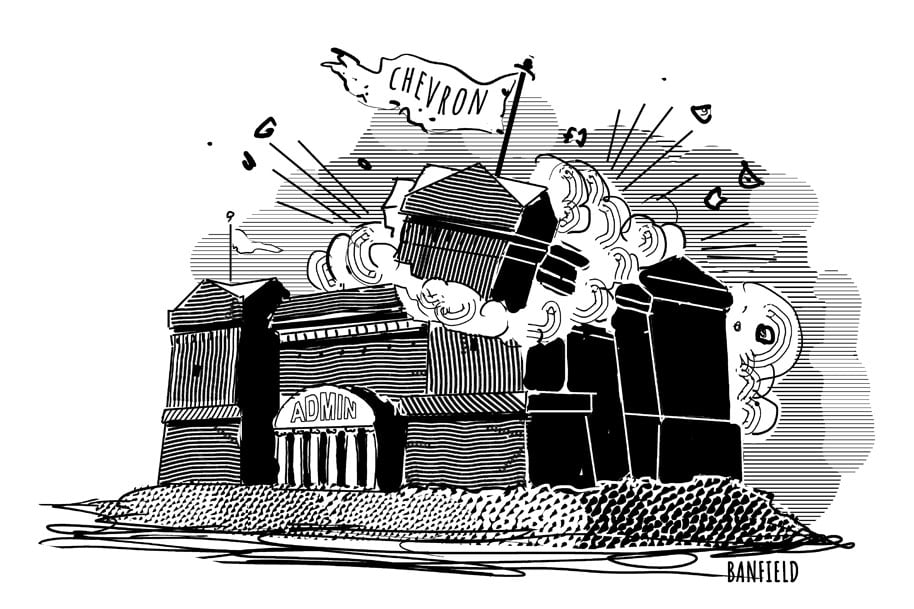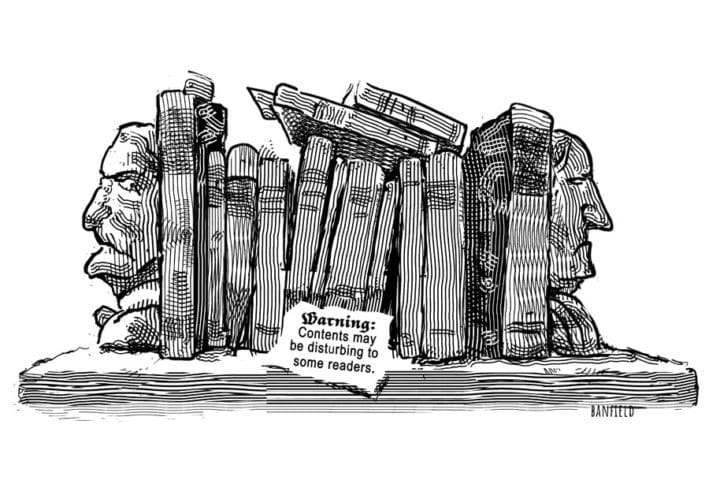Book Reviewed
Administrative law rarely engages attention except among the poor souls who have devoted their professional lives to the field. A signal exception is the Chevron doctrine, named after the Supreme Court’s unanimous 1984 decision in Chevron v. Natural Resources Defense Council. The doctrine commands judicial deference to administrative agency decisions, even on questions of law that would appear to be the courts’ bread and butter. It has inflamed creedal passions far beyond the administrative law dorkdom—and the passions have not always run the same way. Born in the heady days of the Reagan Administration and championed vehemently and to great effect by the late Justice Antonin Scalia, Chevron soon became conservative-originalist orthodoxy. Today, not so much. Chevron, the refrain now rings, is the bastion of an odious, unaccountable “administrative state.” Whence the commotion and confusion about a recondite doctrine?
The question may seem a bit behind the times, insofar as the Chevron doctrine appears to be on its way out at least as a practical matter and in cases that count. As the book’s author notes, the Supreme Court has not decided a case under Chevron since 2016. It has either ignored the doctrine altogether or else, with increasing frequency, blocked highly contested agency regulations—including the Centers for Disease Control’s eviction moratorium, OSHA’s vaccination mandates, and the Environmental Protection Agency’s attempt to revive the Obama Administration’s “Clean Power Plan”—without any deference to agencies and in reliance on canons that place those cases outside Chevron’s domain.
* * *
Even so, there is a great deal to learn from Chevron’s fate. There is no better guide through this terrain than Thomas W. Merrill, Charles Evans Hughes Professor at Columbia Law School. He served in the Solicitor General’s Office at the time of Chevron and, over his illustrious academic career, has written extensively on the subject. His book tracks the doctrine’s history from its curious origins through its unlikely rise and expansion in a hundred-plus Supreme Court decisions to the fairly recent “sudden collapse of support for the doctrine” among legal scholars and judges. His chapters on Chevron’s tortuous trajectory are a must-read for practicing or prospective administrative lawyers. They, as well as a broader audience, will find much good sense in the author’s judicious treatment of perennial questions of lawful government.
Chevron, every law student learns, governs the judicial review of administrative agency action—more precisely, the review of an agency’s legally binding interpretation of a statute that it administers. Justice John Paul Stevens’s opinion established the basic analysis in two brief paragraphs. When Congress has spoken “directly” on the “precise” question at issue, the agency as well as the court must give force to the statute. This is called “Chevron Step 1.” When the statute is “ambiguous,” the agency may adopt any “permissible” or “reasonable” interpretation. This inquiry is extremely deferential: an agency must do something truly idiotic or excessive to lose a “Chevron Step 2” case.
What one makes of this doctrine depends on why and for what one wants judicial review. Merrill examines the problem as a question of “comparative advantage”: which institution, agency, or court is best situated to make this or that decision?
Agencies have substantial advantages. They are more accountable to political institutions and interests than are insulated courts, and they possess expertise in their fields. Courts, on the other hand, are more likely to be “faithful agents” of Congress, and far more likely to look to law rather than political expediency. Thus, Merrill writes, judicial review can and should promote four key values. First, it should promote rule of law values, by which he means the protection of settled expectations. Second, judicial review should sustain constitutional values, including the separation of powers and federalism. Third, it should channel discretionary policy choices toward relatively more accountable institutions, meaning Congress and agencies. Fourth, review should give agencies incentives to make better interpretive choices.
How does Chevron stack up against this list? It depends, Merrill argues, on whether one means Justice Stevens’s lengthy, careful opinion—or the fateful two paragraphs and their later deployment by the federal Court of Appeals for the D.C. Circuit and, in short order, the Supreme Court. Read as a whole, Chevron was something of a model. The opinion explained that no settled expectations had grown up around the program at issue (the Environmental Protection Agency’s to-ing and fro-ing over how to regulate stationary sources under the Clean Air Act). It carefully parsed the statute to discern what a “stationary source” might be, only to come up empty-handed. It emphasized EPA’s accountability to the president, and it noted that the agency had conducted a serious, open rule-making proceeding. Given all that, it was an easy call to leave the substantive policy decision to the EPA.
Sooner than you can say “deference,” though, Chevron’s legendary two paragraphs took on a life of their own. The two-step looked like “simplicity itself”—even moderately competent agency lawyers could write a memo or brief around it. Those actors, moreover, could and did pitch the doctrine as a way of saying “agency wins.” Legal ambiguity is everywhere you look, especially if you want to find it. It then becomes hard to explain why a court, rather than the agency, should decide what is or is not “reasonable.” Courts have reasons to accommodate agency demands for deference: a finding of ambiguity at Step 1 economizes on the time and effort that would otherwise have to be devoted to laborious legal interpretation and judicial deep-dives into messy regulatory schemes.
Chevron’s two-step simplicity, Merrill shows, is deceptive. Both steps of the inquiry are highly indeterminate. The Supreme Court never explained how much or what kind of ambiguity will trigger the move to Step 2, or how much interpretive legal work courts are supposed to do on their own before letting the agency sail on. And neither the Supreme Court nor the appellate courts have explained the “reasonable” yardstick: reasonable in terms of outcomes? Procedures? Acceptability?
These questions matter. Justice Scalia, Chevron’s principal advocate, insisted on doing his own interpretive work, with the result that the agencies often lost. Contrariwise, Justice Stephen Breyer—Chevron’s most ardent foe on the Court—insisted that questions of law must always be decided by courts, not agencies. Except there isn’t a lot of law to be had in the general run of cases, which means that the agency gets its wish unless it breaks some ironclad statutory prohibition.
* * *
In that random shape and deployment, Chevron flunks all four of Merrill’s values. It increases judicial discretion—less politely, judicial willfulness. It gives agencies no incentive to dot their i’s and cross their t’s, or to pay heed to settled expectations. Above all, it pushes courts away from their central task and their most valuable contribution to the enterprise. An earlier age called that task ultra vires review. Merrill calls it “boundary enforcement”: did the agency have affirmative legal authority to do this particular thing, with binding effect?
The Supreme Court’s principal response to this rule-of-law problem has been to improvise its way toward, shall we say, Merrillean values and boundary enforcement. Its dominant strategy has been to lard up the Step 1 analysis with extraneous substantive canons of interpretation. If, for instance, an agency’s statutory interpretation raises constitutional doubts, poses federalism concerns, or presents a “major question,” the court and not the agency will make the call—ambiguity or not. Litigants have understandably sought to make the most of those maneuvers, with considerable success. The COVID and clean power cases mentioned earlier, among several others, were all decided under one or another of the Court’s Chevron-avoiding doctrines.
Merrill is not fond of such improvisation. Nor, on the other hand, does he believe that the Supreme Court will, or should, jettison the doctrine. Instead, he proposes to reform the Chevron framework. Apart from the indeterminacy of “clear” and “reasonable,” he argues, the doctrine suffers from an additional flaw. According to its dominant formulation, advanced in a famous 1989 Duke Law Journal article by Justice Scalia, Chevron is a delegation doctrine: it rests on the acknowledged fiction that statutory ambiguity means that Congress intended the agency, not the courts, to make the relevant decision. Merrill proposes to invert the default rule. “The better baseline assumption,” he writes, “is that questions of law must be resolved by courts, unless Congress has actually delegated authority to the agency to act as the primary interpreter with respect to the provision in question.” Merrill identifies six general principles, all eminently sensible, to guide that boundary-enforcing inquiry. If the agency lacks that authority, case closed. If it does possess it, courts should let the agency’s interpretation stand unless the bureaucrats obviously mangled the law. As for “reasonableness,” Merrill would focus the analysis on the agency’s decision-making process and grant deference to the extent that the agency followed transparent, notice-and-comment-like procedures.
All this is doctrinally and directionally right, and importantly so. The Supreme Court is in fact highly unlikely to junk Chevron any time soon. In addition to some other things neither the High Court nor the lower courts will want to get bogged down in cases involving low stakes and regulatory minutiae. The Court will, however, continue to refashion the doctrine. Here’s to hoping that the Justices will heed Merrill’s sure-footed guidance.
What this entails for “the future of the administrative state” more broadly is a somewhat different question. The book’s subtitle, frankly, is a bit of an oversell: Merrill is quite diffident about “the future of the administrative state.” In his introductory pages, he places his position between prominent critics (for example, the American Enterprise Institute’s Peter Wallison) and staunch defenders (for example, Harvard’s Adrian Vermeule) of the administrative state and its legitimacy. The author fairly and frankly locates himself closer to the Vermeule end. Unlike Vermeule, however, he insists that courts have something to contribute to the administrative enterprise, as guardians of congressional intent and instruments of boundary control. He is right about that, too.
* * *
Still, Merrill’s perspective will fail to persuade readers whose concerns don’t revolve around the day-to-day operation of the administrative state but around its basic legitimacy. His approach is fairly described as a modified limited New Deal hangout. The notion that courts should be Congress’s “faithful agents,” rather than a check on that institution; the idea that rule-of-law considerations can be reduced to the protection of “settled expectations,” as distinct from protecting private spheres of right where coercive government action requires full-scale judicial review; the appeal to “comparative advantage,” as distinct from formal powers and constitutional constraints; the emphasis on accountability and expertise: all are ideas straight from the New Deal and Legal Process playbook.
One need not share overwrought legitimacy concerns to suspect that this playbook is out of date. In an era of presidential government, we no longer have an operative, attentive Congress whose mandates faithful judicial agents could reasonably discern. The principal judicial review question is when and how agencies may make ancient statutes do astounding new tricks. No regulated industry can have any settled expectation with respect to existing rules other than that the next administration will probably command the opposite. Appeals to “accountability” seem suspect when agencies are “accountable” to a hyperpartisan White House and to their insular stakeholder networks. Likewise, citizens who have lived through on-and-off lockdowns, mask requirements, vaccination mandates, and, now, supposedly transitory inflation are reasonably suspicious of the experts who engineered those feats. Anxieties of this sort resonate powerfully in the Court’s decisions and opinions.
Ever since its inception, the Chevron debate has served as a placeholder for more fundamental contentions. Its salience is apt to recede as those contentions—over the constitutional limits of congressional delegation, for example, or agencies’ power to adjudicate private rights—now play out in the courts or in ordinary politics. I suspect that Thomas Merrill and I agree on that observation, as we do on much else.





